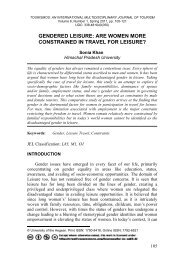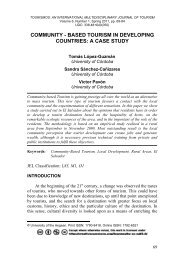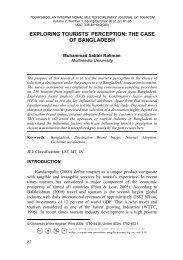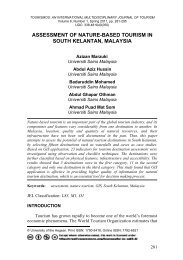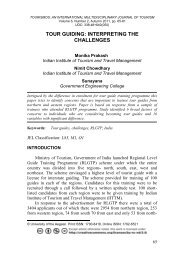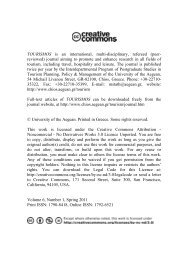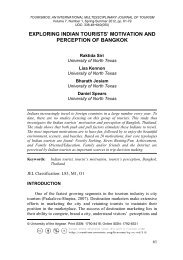ECONOMIC POTENTIAL OF TOURISM : A CASE STUDY OF AGRA
ECONOMIC POTENTIAL OF TOURISM : A CASE STUDY OF AGRA
ECONOMIC POTENTIAL OF TOURISM : A CASE STUDY OF AGRA
You also want an ePaper? Increase the reach of your titles
YUMPU automatically turns print PDFs into web optimized ePapers that Google loves.
<strong>TOURISM</strong>OS: AN INTERNATIONAL MULTIDISCIPLINARY JOURNAL <strong>OF</strong> <strong>TOURISM</strong><br />
Volume 6, Number 2, Autumn 2011, pp. 139-158<br />
UDC: 338.48+640(050)<br />
one comes to Agra.But in real terms Fatehpur Sikri is a place where one<br />
should spend some time. The sunset over the ruins is sight to cherish.<br />
Fatehpur Sikri is the best example of the culmination of Hindu and<br />
Muslim architecture. Fatehpur Sikri Mosque is said to be a copy of the<br />
mosque in Mecca and has designs, derived from the Persian & Hindu<br />
architecture.<br />
The Main Attractions<br />
Diwani-i-Am<br />
Diwani-i-Khas<br />
Jodhabai‟s Palace<br />
Friday Mosque<br />
Salim Chisti‟s Mausoleum<br />
Sikandara<br />
This monument is only 13 km. from the Agra Fort. Akbar who ruled<br />
over the Mughal Empire from 1556 to 1605, began building his<br />
mausoleum in the spartan style of Timurid architecture. The<br />
mausoleum was completed by his son, the next Mughal Emperor,<br />
Jahangir, who added more decorative elements to the design of Akbar's<br />
tomb in Sikandra.<br />
The entrance to Akbar's tomb in Sikandra is under a huge arched<br />
gateway, similar to the Buland Darwaza at Fatehpur Sikri. There are<br />
beautiful calligraphic inscriptions on the white marble front of the gate.<br />
As you enter the gate you will see a formal garden in the charbagh<br />
tradition, and the tomb of Akbar situated at the center. Within the same<br />
complex is another sober tomb made of red sandstone, which contains the<br />
grave of Akbar's wife Mariam, the mother of Jahangir.<br />
Akbar's tomb in Sikandra is built in a pyramidal shape, with an open<br />
terrace covered with carved latticework screens. The actual grave is in the<br />
basement and is decorated with paintings in colorful golden, green and<br />
blue hues on the stucco walls.The last resting place of the Mughal<br />
emperor Akbar was this city. Akbar was the greatest of the Mughal<br />
emperors and one of the most secular minded royalties of his time. He<br />
was the heir to a long tradition of oriental refinement, a great patron of the<br />
arts, literature, philosophy and science.<br />
Itmad-ud-Daula is the tomb of Mirza Ghiyas Beg, a Persian who<br />
had obtained service in Akbar's court. The tomb set a startling precedent<br />
as the first Mughal building to be face with white inlaid marble and<br />
147



